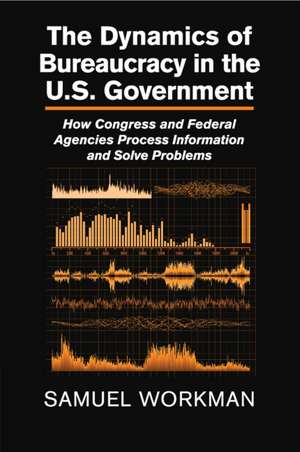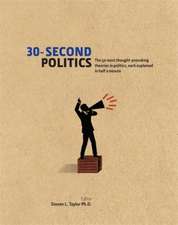The Dynamics of Bureaucracy in the US Government: How Congress and Federal Agencies Process Information and Solve Problems
Autor Samuel Workmanen Limba Engleză Paperback – 12 iun 2019
| Toate formatele și edițiile | Preț | Express |
|---|---|---|
| Paperback (1) | 281.88 lei 6-8 săpt. | |
| Cambridge University Press – 12 iun 2019 | 281.88 lei 6-8 săpt. | |
| Hardback (1) | 717.71 lei 6-8 săpt. | |
| Cambridge University Press – 15 apr 2015 | 717.71 lei 6-8 săpt. |
Preț: 281.88 lei
Nou
Puncte Express: 423
Preț estimativ în valută:
53.94€ • 58.83$ • 45.48£
53.94€ • 58.83$ • 45.48£
Carte tipărită la comandă
Livrare economică 24 aprilie-08 mai
Preluare comenzi: 021 569.72.76
Specificații
ISBN-13: 9781107679559
ISBN-10: 1107679559
Pagini: 207
Ilustrații: 16 tables
Dimensiuni: 152 x 228 x 18 mm
Greutate: 0.31 kg
Editura: Cambridge University Press
Colecția Cambridge University Press
Locul publicării:New York, United States
ISBN-10: 1107679559
Pagini: 207
Ilustrații: 16 tables
Dimensiuni: 152 x 228 x 18 mm
Greutate: 0.31 kg
Editura: Cambridge University Press
Colecția Cambridge University Press
Locul publicării:New York, United States
Cuprins
1. Bureaucracy and problem-solving; 2. The dual dynamics of the administrative state; 3. The regulatory process as an attention mechanism; 4. Problem monitoring in the administrative state; 5. Problem prioritization and demand for information; 6. Problem-solving and the supply of information; 7. Information, bureaucracy, and government problem solving; Appendix A. Conceptualization and measurement; Appendix B. Statistical models.
Recenzii
'Workman proposes an important and completely novel perspective on the relations between Congress and the bureaucracy. Based on a newly collected database of every federal regulation since the 1980s, he shows that Congressional committees and federal agencies are engaged in a mutual dance in which new information coming from agencies signals to Congress that developments require more attention or activity, and that the diversity or range in sources of the regulatory activity signal which parts of the issue require congressional intervention. The book is a model of methodology, theory building, and addressing an important issue of great substantive value: how does government set its agenda, and what is the role of the regulatory apparatus of the state in doing so? It will be seen as a major contribution to the literatures on agenda setting, bureaucratic politics, and congressional policy making for years to come.' Frank R. Baumgartner, University of North Carolina, Chapel Hill
'This is a book that forces us to think about the policy-making process in new ways. It puts bureaucracy at center stage. Rather than characterize the administrative state as the passive implementer of political decisions by elected officials, Workman argues that federal agencies are strategic actors competing for Congress's attention. Congress, in turn, is trying to learn from the administrative state and shape its information-providing activities. This is a book that utilizes amazing new data to illuminate how agencies influence the policy agenda and policy process as attention-seeking and attention-directing institutions.' David E. Lewis, Vanderbilt University, Tennessee
'This is a book that forces us to think about the policy-making process in new ways. It puts bureaucracy at center stage. Rather than characterize the administrative state as the passive implementer of political decisions by elected officials, Workman argues that federal agencies are strategic actors competing for Congress's attention. Congress, in turn, is trying to learn from the administrative state and shape its information-providing activities. This is a book that utilizes amazing new data to illuminate how agencies influence the policy agenda and policy process as attention-seeking and attention-directing institutions.' David E. Lewis, Vanderbilt University, Tennessee
Notă biografică
Descriere
This book assesses the influence of bureaucracy in American politics.


















